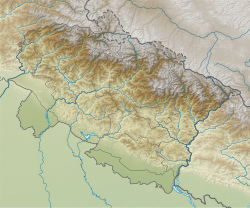Bageshwar | |
|---|---|
Town | |
|
Clockwise from top: View of Bageshwar, Sarju Ghat, Lord Shiva Statue, Suspension Bridge on the Sarju and Bagnath Temple | |
| Coordinates: 29°50′17″N 79°46′16″E / 29.838°N 79.771°E | |
| Country | |
| State | Uttarakhand |
| Division | Kumaon |
| District | Bageshwar |
| Government | |
| • Type | Municipality |
| • Body | Nagar Palika Parishad Bageshwar[1] |
| Area | |
• Total | 5.50 km2 (2.12 sq mi) |
| Elevation | 935 m (3,068 ft) |
| Population | |
• Total | 9,079 |
| • Density | 1,700/km2 (4,300/sq mi) |
| Languages | |
| • Official | Hindi Sanskrit |
| • Native | Kumaoni |
| Time zone | UTC+5:30 (IST) |
| PIN | |
| Vehicle registration | UK-02 |
| Website | uk |
Bageshwar (Kumaoni: Bāgshyār) is a town and a municipal board in Bageshwar district in the state of Uttarakhand, India. It is located at a distance of 470 km from the National Capital New Delhi and 332 km from the State Capital Dehradun.[2] Bageshwar is known for its scenic environment, glaciers, rivers and temples. It is also the administrative headquarters of Bageshwar district.[3]
Situated on the confluence of Saryu and Gomati rivers,[4][5] Bageshwar is surrounded by the mountains of Bhileshwar and Nileshwar to its east and west, the Suraj Kund in the north, and Agni Kund in the south. Bageshwar was a major trade mart between Tibet and Kumaun, and was frequented by the Bhotia traders, who bartered Tibetan wares, wool, salt and Borax in exchange for carpets and other local produces in Bageshwar.[6] The trade routes were, however, closed after the Indo-China War of 1962.
The city is of great religious, historic and political significance. Bageshwar is mentioned in various Puranas, where it has been associated with Shiva.[7] The Uttrayani fair held annually in Bageshwar used to be visited by approx 15,000 people in the early twentieth century, and was the largest fair of Kumaon division.[8] The fair became the epicenter of the Coolie Begar Movement in January 1921.[9] The city of Bageshwar gets its name from the Bagnath Temple.[10] Hindi and Sanskrit are the official Languages however Kumaoni is spoken by a large number of people.
- ^ "Bageshwar Municipality". 18 June 2024.
- ^ Indusnettechnologies, Goutam Pal, Dipak K S, SWD. "Location: District of Bageshwar, Uttarakhand, India". bageshwar.nic.in. Retrieved 3 August 2016.
{{cite web}}: CS1 maint: multiple names: authors list (link) - ^ "Bageshwar PinCode". citypincode.in. Archived from the original on 8 December 2015. Retrieved 17 March 2014.
- ^ Dehradun, NIC, Uttarakhand State Unit. "District of Almora, Uttarakhand, India". almora.nic.in. Retrieved 9 September 2016.
{{cite web}}: CS1 maint: multiple names: authors list (link) - ^ "नमामी सरयू योजना शुरू करे सरकार 14430986". Retrieved 3 August 2016.
- ^ Bageshwar, The Imperial Gazetter of India, 1909
- ^ "Uttarayani fest to bring Kumaon, Garhwal together". The Times of India. Almora. TNN. 3 January 2015. Retrieved 7 July 2017.
- ^ Walton, H. G. (1911). Almora: A Gazetter. Allahabad: The Government Press, United Provinces. p. Appendix XXIV.
- ^ "Struggle against 'kuli beggar' was launched on Uttarayani". The Tribune. Pithoragarh. 14 January 2014. Retrieved 7 July 2017.
- ^ "development gains elude kumaon's holy place". Retrieved 3 August 2016.






